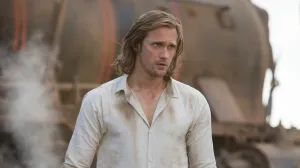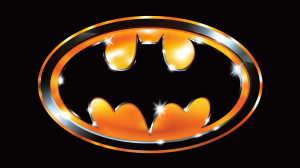Dave Baker’s Mary Tyler MooreHawk is in stores today from Top Shelf. We called it “a masterpiece,” so you could probably guess it’s worth at least a look. Baker, who has spent the last few years writing everything from violent, meta superheroes in Halloween Boy to all-ages Teenage Mutant Ninja Turtles stories, has worked quietly on Mary Tyler MooreHawk in the background for years. Speaking with ComicBook.com, he admits that the official mythology is that he has been developing the book for five years, but he thinks it was probably longer than that if he’s being honest with himself.
Videos by ComicBook.com
Mary Tyler MooreHawk tells, at face value, two stories: the first is the adventures of a “not-quite-teen adventurer” (Mary Tyler MooreHawk), whose adventures are in the vein of Jonny Quest or Nancy Drew (albeit with a cosmic twist). The second is the story of Dave Baker, a journalist obsessed with a short-lived TV show that was made based on the Mary Tyler MooreHawk comic book. He is, in turn, trying to track down a different Dave Baker – this one a reclusive cartoonist who created the original comic on which the show was based.
“I think I’m only in it three times, all right?” Baker joked. “That’s actually something I debated. That idea, that there would be multiple ‘mes’ in it, happened over the course of making it. Then I was like, ‘Is this stupid? Should I not do this?’ It was so funny to me that I had to. Now you’ve caught me at that dip again, where I’m like, ‘Is it that funny?’ I don’t know.”
The book’s production was a long one, not just because it’s incredibly dense and detailed — you could get that from projects like Forest Hills Bootleg Society or Halloween Boy, both of which took significantly less time — but because the project keeps evolving. In other interviews, Baker has said that the process kept changing, because with nobody to please but himself, he kept allowing himself to be distracted by new ideas, which expanded the scale and warped the shape of the final product.
“The reasons why this book took so long is two-pronged. One was convincing somebody to actually bet on this weird thing that’s not just a comic. Then the other part was me figuring out how to do all of the things that I had this vision for, both from the design perspective, the structural perspective, and then the literal ones and zeros perspective,” Baker explained. “I retrained myself how to draw while doing this. I eschewed inking. I retaught myself how to letter digitally. I use a process now, where I do my construction lines in red pencil, and then do my finished lines as, basically, my first drawing, so everything got speeded up. But figuring out that process was a very lengthy process itself. Now, in the interim between having signed the deal with Top Shelf — thank you Top Shelf for publishing this — I’ve drawn a whole other book, because I now know how that process works, and it’s infinitely faster.”
Mary Tyler MooreHawk started as Series Finale: The Series, a fake behind-the-scenes book exploring the production troubles of a fictional show. Even then, the “kid adventurer” thing with Mary Tyler MooreHawk as a main character was intact. Originally, Series Finale: The Series was to be an anthology of different stories, each one being the finale to a different fake series. Over time, though, almost everything else fell away. There’s even a reference in the final book to how difficult it is to find behind-the-scenes writing about MTMH.
“Then I was like, ‘Oh, it’d be really fun to pretend like it was based on a comic, and have a mini comic in that that you could read,’” Baker told ComicBook.com. “You’d read the pilot, and then you’d read this little mini comic, and then you’d go on to the next chapter of series nine of the series. That opening sequence, them escaping from the temple, and Jean-Gerard Jetcar stuff, all of that stuff was just going to be a mini comic. Then I was like, ‘Actually, I don’t care about any of these other pilots or ideas. I’m just going to do this.’ Then it morphed into there would be comics, and then interspersed with that, you’d read old episodes of the TV show that was canceled. Then it moved into what it is now, where it’s just a completely other, just way out in left field thing.”
Baker’s work is so complex and formally inventive that virtually every review up to this point — ours included — has included some reference to The House of Leaves or Infinite Jest. That’s maybe a little less obvious to casual readers is the obvious debt the work owes to The Adventures of Buckaroo Banzai Across the 8th Dimension, and to Casanova by Matt Fraction, Gabriel Bá, and Fábio Moon.
“Buckaroo Banzai is my favorite thing ever. It’s like that and Casanova, by Fraction, Bá, and Moon. I think both of those are pretty apparently laced into the narrative of MTMH,” Baker said.
Like Rauch’s Buckaroo Banzai, Mary Tyler MooreHawk inhabits a world where she has had a long string of adventures before this book, and will presumably continue to have more after (as long as she can save the world this time). Rauch’s idea, unique for a big-budget Hollywood movie at the time, was to pretend audiences were watching the latest in a series of Buckaroo Banzai blockbusters. For Rauch’s part, he approves of Baker’s homage: he provided a pull quote for the back cover of Mary Tyler Moorehawk.
Even a project as bold and weird as Mary Tyler MooreHawk is eventually going to come up against the constraints of reality a little bit, though. Baker, who didn’t connect with Top Shelf until fairly late in the process, said that he had wanted to have more fake behind-the-scenes stuff from the Mary Tyler MooreHawk TV show — but he couldn’t find a way to make it make sense.
“At one point in time, I was talking about doing photo shoots with actors playing the people, but I just couldn’t figure it out,” he admitted. “I couldn’t get the logistics of paying for the costumes, and the actors, and the stuff. It was just too much. But if I ever do a sequel, that’s what I would want to do. I would want to do staged behind-the-scenes photos, where there’s people gesturing comedically, or posing with guns, or whatever.”
As for a title? He joked, “Mary Tyler MooreHawk II: More Meta Bullshit.”
Of course, half the book is dense and complex. The other half is an updated, cosmic take on Jonny Quest. Baker knows that for some people, especially those who found his work through comparably more commercial projects like Star Trek: Voyager – Seven’s Reckoning, it might be a very different reading experience than it is for those who come looking for an experimental, formalist experiment.
“I think there’s going to be two types of reading experiences, and I think frankly, most people are just going to read the comics,” Baker admitted. “They’re going to skim some of the other stuff, and then be like, ‘All right, I get it. He is looking for a weird old version of himself, maybe, or something. Moving on.’ Which is fine. That’s one of the things I like about comics, is that some people read the words first, some people read the images, some people scan the whole page. Some people are very fastidious, and only go panel by panel. I think that’s interesting, and I wish more comics required more of the reader, so that there could be a variance in how people process the information, and a cornucopia of reading experiences that would then spark conversations in between people.”
He added, “One of the big creative influences for the book is Mark Z. Danielewski’s The House of Leaves. I think that’s also a thing in that book, where some people just want to read the spooky horror story of the house that’s bigger on the inside than on the out. Some people really get into it, and some people are obsessed with the letters at the end, and all of these little hidden messages. I’m excited to see how it’s received in various sectors because of that. I think it’s cool.”
Mary Tyler MooreHawk is in stores now.








